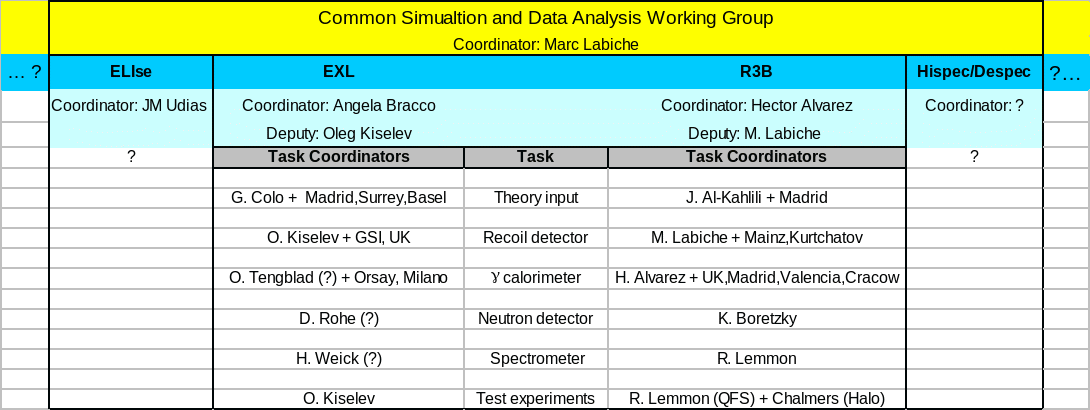SHOTLIST AIM DEFLECTING ASTEROIDS TO PROTECT EARTH INTERNET DESCRIPTION
SHOTLIST AIM DEFLECTING ASTEROIDS TO PROTECT EARTH INTERNET DESCRIPTION
SHOTLIST AIM: Deflecting asteroids to protect Earth
Internet description:
Our Earth is constantly bombarded by small asteroids that try to penetrate its protective atmosphere. The vast majority don't get through, but larger asteroids could pose a threat.. Understanding better what asteroids are made of is crucial in improving deflection technologies to set them off a collision course. This is one of the main objectives of AIM, ESA's preliminary Asteroid Impact Mission.
TC 00 00 00 Generic and title
AIM: Deflecting asteroids to protect Earth
00 00 10
TEXT
Major asteroid impacts have played a big role in the evolution of life on Earth, and in the dinosaurs’ mass extinction. Yet even today, smaller-scale asteroids hit the Earth every few decades… sometimes causing significant damage and even injury...
(ESA animations of an asteroid impacting Earth and real images of the Chelyabinsk meteor impact over this Russia city on 15/02/2013)
00 00 28
Understanding better the surface and internal structure of asteroids is crucial in improving deflection technologies to set them off a collision course. This is one of the main objectives of AIM, ESA's asteroid deflection precursor mission.
(Asteroid animation provided by Hubble Spacetelescope web: www.spacetelescope.org, and AIM animations by ESA)
00 00 45
SOUNDBITE Michael KUEPPERS, AIM Project Scientist, ESA (in German)
AIM's main objective is to test how we could protect ourselves from an asteroid impact that could potentially threaten Earth. It will investigate a double asteroid to better understand the properties of asteroids with a view to avoiding a potential impact.
(Soundbite covered partly with images of AIM animations by ESA)
00 01 05
TEXT
If it gets the green light, AIM would be launched in late 2020 on a Soyuz rocket and travel 11 million kms into space until it reaches Didymos, a relatively small asteroid orbited by Didymoon. This smaller moon is AIM's focus...
(AIM animations by ESA)
00 01 24
SOUNDBITE Ian CARNELLI, AIM Head of Mission, ESA (in English)
AIM will rendezvous with Didymos in June 2022. The first thing it will do is to take high resolution images so we can reconstruct a 3D shape of the moon, and then we will use this data to test a new optical communications system with a laser transmitting these images down to Earth. After we do these measurements, we will sound the interior structure of the asteroid by deploying a small micro lander on its surface that will emit small radio waves that will cached by AIM and reconstruct the interior structure.
(Soundbite covered partly with images of AIM animations by ESA)
00 01 57
TEXT
Once the first measurements have been taken, AIM will move to a safe distance to observe the impact of DART, the NASA-built asteroid impactor which, coupled with AIM, forms the basis of the larger Asteroid Impact and Deflection Assessment mission.
By measuring Didymoon’s physical properties and its orbit before and after DART's impact, scientists will gain valuable knowledge that can be applied to a real threat should it ever occur... In addition, scientists will learn how these double celestial bodies form, answering fundamental questions on the formation of the Solar System.
(Soundbite covered partly with images of AIM animations by ESA)
00 02 34
SOUNDBITE Ian CARNELLI, Head of AIM Mission, ESA (in English)
AIM is the first mission to test the kinetic impact deflection technique, it's the first mission that will prove deep-space optical communication systems and it's the first mission to deploy cube-sats in space and test intersatellite communication systems. Also, it will be the first mission to rendezvous with a binary asteroid and characterize it.
(Soundbite covered partly with images of AIM animations by ESA)
00 02 58
TEXT
That's a lot of firsts for a single mission! If the AIM design meets the approval of ESA's Member States, engineers could start making the spacecraft's hardware and payload by the end of next year, to be ready for launch in 2020!
(AIM animations by ESA, people working in the Copernicus/Sentinel mission control room at ESOC, Germany, November 2014, and exterior view of ESTEC, ESA's centre in the Netherlands)
00 03 17
END of A-roll and beginning of B-roll
SOUNDBITE Michael KUEPPERS, AIM Project Scientist, ESA (in German)
AIM's main objective is to test how we could protect ourselves from an asteroid impact that could potentially threaten Earth. It will investigate a double asteroid to better understand the properties of asteroids with a view to avoiding a potential impact. A projectile would be launched to the asteroid, its impact deflecting the asteroid from its collision course.
00 03 54
SOUNDBITE Michael KUEPPERS, AIM Project Scientist, ESA (in German)
In addition to technology demonstration for asteroid deflection, it's also a purpose of AIM to do asteroid science so it investigates the structure of the asteroid to understand what they are made of, and also to understand how such a double asteroid with a moon forms.
00 04 18
Cutaway interview with Michael KUEPPERS
00 04 34
SOUNDBITE Ian CARNELLI, AIM Head of Mission, ESA (in English)
AIM will rendezvous with Didymos in June 2022. The first thing it will do is to take high resolution images so we can reconstruct a 3D shape of the moon, and then we will use this data to test a new optical communications system with a laser transmitting these images down to Earth in a very quick way. After we do these measurements and we have a 3D model we will sound the interior structure of the asteroid by deploying a small micro lander on its surface that will emit small radio waves that will cached by AIM and reconstruct the interior structure.
00 05 22
After we have done these measurements the spacecraft will move away about 100 km from the system waiting for DART to arrive and impact on the moon. Once the impact has occurred and we'll look at the ejecta and the dynamics of the ejecta cloud we'll come closer to the moon and repeat the same sets of measurements so that we can understand the changes in the interior structure, the shape and the morphology of the crater before and after the impact.
00 05 50
SOUNDBITE Ian CARNELLI, Head of AIM Mission, ESA (in English)
AIM is the first mission to test the kinetic impact deflection technique, it's the first mission that will prove deep-space optical communication systems and it's the first mission to deploy cube-sats in space and test intersatellite communication systems. It's also the first mission to rendezvous with a binary asteroid and characterize it so that we can understand how these bodies are formed, which is highly linked to the way the solar system was formed.
00 06 21
Cutaways of interview with Ian Carnelli (3 shots)
00 06 55
SOUNDBITE IAN CARNELLI, Head of AIM Mission, ESA (in French)
AIM will rendezvous with Didymos in June 2022. The first thing it will do is to take high resolution images so we can reconstruct a 3D shape of the moon, and then we will use this data to test a new optical communications system with a laser transmitting these images down to Earth. After we do these measurements and we have a 3D model we will sound the interior structure of the asteroid by deploying a small micro lander on its surface that will emit low frequency radio waves that will cached by AIM and reconstruct the interior structure. Afterwards, we will release two small cubesats, which will bring the asteroid closer and take high resolution images. After we have done these measurements the spacecraft will move away about 100 km from the system waiting for DART to arrive and impact on the moon. Once the impact has occurred and we'll look at the ejecta and the dynamics of the ejecta cloud we'll come closer to the moon and repeat the same sets of measurements so that we can understand the changes in the interior structure, the shape and the morphology of the crater before and after the impact.
00 08 30
Exterior views of ESTEC, ESA's centre in the Netherlands (5 shots)
00 09 92
AIM animations
00 14 06
END of B-roll
Music library used:
Tracks used (free tracks):
-Running out of time
-Dark ambience
-Strange view
Please mention the music when you upload the shotlist on the ESA web
Tags: asteroids to, of asteroids, deflecting, description, asteroids, internet, earth, protect, shotlist
- TO MY SISTER I’M SORRY FOR NOT BEING THERE
- REVIEW FOR PROBABILITY TEST – CHAPTER 13 AND 14
- SZOLGÁLTATÁSI SZERZŐDÉS AMELY EGYRÉSZRŐL A(Z) NEVE SZÉKHELYE
- RADIO TELESCOPIO (MODELO DIDÁCTICO ARMABLE) ABRAHAM LUNA CASTELLANOS ASTROABC©
- CHILDREN WITH SPECIAL NEEDS 107 NOTT TERRACE SUITE 306
- REQUIREMENTS ASSESSMENT SRI LANKA NATIONAL SPATIAL DATA INFRASTRUCTURE SUPPORTING
- REVISION 6 DATE 05312009 DEPARTMENT OF TRANSPORTATION FEDERAL AVIATION
- KATHOLIEKE UNIVERSITEIT LEUVEN FACULTEIT BEWEGINGS EN REVALIDATIEWETENSCHAPPEN VOORAFNAME VAN
- EDYTOR MICROSOFT WORD 20 UTWORZENIE NOWEGO DOKUMENTU PO URUCHOMIENIU
- TRACKING SHEET – WORKING WITH YOUNG PEOPLE WHO DISPLAY
- PRISON REFORM TRUST SUBMISSION PARLIAMENTARY INQUIRY INTO THE OPERATION
- AUTORIZACIÓN PARA USO DE IMAGEN YO IDENTIFICADO CON
- APLIKACIJA ZA ZAPOŠLJAVANJE LIČNE INFORMACIJE IME I PREZIME RESTORAN
- CAP IT S 3 LES INSTALLATIONS ET LES ÉQUIPEMENTS
- MISTRZOSTWA POLSKI JUNIORÓW I SENIORÓW GDYNIA 67062009 50 M
- HTTPWWWUNIBGITBACHECA 20112012 F I L O L O G
- PROJEKT UCHWAŁA NR RADY GMINY DĘBNO Z DNIA
- S ILABUS KELAS VII SMPMTS – BAHASA INDONESIA SILABUS
- LII COSAC ROME 12 DECEMBER 2014 WELCOMING SPEECH BY
- UNCLASSIFIED NOTIFICATION AND REVIEW PROCEDURES FOR SERIOUS FURTHER OFFENCES
- EXPLANATION OF HIGH RISK FACTORS IN FAMILY AND DOMESTIC
- REGULADOR ELECTRÓNICO DE POTENCIA PUEDEN SER DE 400
- MENSAJE ORIGINAL DE XXXXONOCOM [XXXXXXXX] ENVIADO EL JUEVES 27
- NEWS RELEASE WHO46 PAGE 0 NEWS RELEASE WHO46 10
- (INSERT AGENCY NAME) REPRODUCTIVE HEALTH PROGRAM ADMINISTRATIVE POLICIES AND
- CAMPAÑAS PRESENTADAS EN LOS PREMIOS IMÁN 2007 PREMIOS
- ALL INFORMATION CONTAINED HEREIN IS STRICTLY CONFIDENTIAL 1 PERSONAL
- İŞ AKIŞ ŞEMASI BİRİM DOĞUBAYAZIT AHMEDİ HANİ MESLEK YÜKSEKOKULU
- MODULO PER L’ INSERIMENTO NELL’ELENCO DI DIRIGENTI MEDICI ISCRITTI
- APLICACIONES DE LAS PROPIEDADES COLIGATIVAS ASIGNATURA QUÍMICA DE LAS
ANXIETY AND THE BEHAVIOURAL INHIBITION SYSTEM PHILIP J CORR
 9 CMDT9835F UNION INTERNATIONALE DES TÉLÉCOMMUNICATIONS BUREAU
9 CMDT9835F UNION INTERNATIONALE DES TÉLÉCOMMUNICATIONS BUREAU 7 D EPARTAMENTO JURIDICO K5541(545)2002 DN 997 ORD
7 D EPARTAMENTO JURIDICO K5541(545)2002 DN 997 ORD ALGEMEEN HUISHOUDELIJK REGLEMENT VAN DE VERENIGING “[NAAM VERENIGING]” HOOFDSTUK
ALGEMEEN HUISHOUDELIJK REGLEMENT VAN DE VERENIGING “[NAAM VERENIGING]” HOOFDSTUK HIGH TECH HIDEANDSEEK HOW CAN YOU USE A
HIGH TECH HIDEANDSEEK HOW CAN YOU USE AVII TURNIEJ TAŃCA NOWOCZESNEGO O PUCHAR BURMISTRZA ŁĘCZNEJ 1
 MANSFIELD COMMUNITY LEARNING DISABILITY TEAM REFERRAL FORM WHEREVER
MANSFIELD COMMUNITY LEARNING DISABILITY TEAM REFERRAL FORM WHEREVER 52222 KOROMAČNO KOROMAČNO PP 5 OIB 93627811741 IBAN
52222 KOROMAČNO KOROMAČNO PP 5 OIB 93627811741 IBAN UNIVERSITATEA DE MEDICINĂ ŞI FARMACIE „VICTOR BABEŞ” DIN
DECLARACIÓN JURADA PARA PERROS PELIGROSOS FECHA NOMBRE DEL
 MEMORANDUM ELECTRONIC GOVERNMENT 3 ELECTRONIC GOVERNMENT ALS SCHLÜSSEL ZUR
MEMORANDUM ELECTRONIC GOVERNMENT 3 ELECTRONIC GOVERNMENT ALS SCHLÜSSEL ZUR MINUTE OF THE FIRST SIMULATION AND DATA ANALYSIS
MINUTE OF THE FIRST SIMULATION AND DATA ANALYSIS CURRICULUM VITAE PERSONAL DATA SURNAME UBOH OTHER NAMES
CURRICULUM VITAE PERSONAL DATA SURNAME UBOH OTHER NAMESTC DENİZ KUVVETLERİ KOMUTANLIĞI KUZEY DENIZ SAHA KOMUTANLIĞI SEYIR
ENGINEERING COUNCIL OF SOUTH AFRICA (13042012) FORM A21 TRAININGEXPERIENCE
 & COUNCIL OF CIVIL SERVICE UNIONS GOOD PRACTICE FOR
& COUNCIL OF CIVIL SERVICE UNIONS GOOD PRACTICE FOR STATE OF CALIFORNIA DEPARTMENT OF FOOD AND AGRICULTURE SAFE
STATE OF CALIFORNIA DEPARTMENT OF FOOD AND AGRICULTURE SAFE SERVEI DE MENJADOR KUKUTAI ÉS UN ESPAI D’OCI PENSAT
SERVEI DE MENJADOR KUKUTAI ÉS UN ESPAI D’OCI PENSAT0 CONSEJO PERMANENTE DE LA OEASERKXVI ORGANIZACIÓN DE LOS
IL CINEMA RITROVATO ON TOUR REDISCOVERED CINEMA ON TOUR